Austin Western, 1877 to 1978:
Once the 'Gold Standard' of Sweeping and Road Equipment
Austin-Western was the first road machinery company, with its origins dating back to the start of modern road building after the civil war. In the 1950's, as the Interstate highway commitment signaled the last of that great road infrastructure boom, Austin-Western was paired with Baldwin Locomotive, a holdover from the great age of steam.
However, by then steam locomotives were obsolete and the firm was desperately trying to survive through diversification into road construction. This may illustrate the rise of road building during which Austin-Western prospered.
by Ranger Kidwell-Ross
Posted December 2011
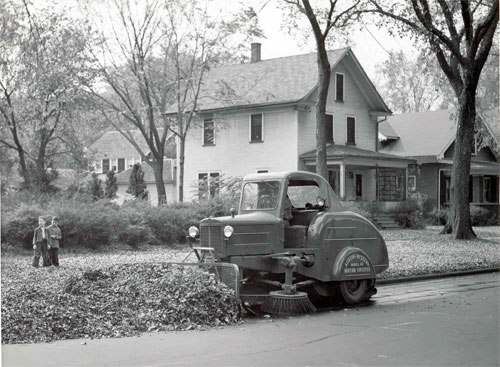
What became Austin-Western started in 1877 in Mount Prospect, Iowa, by Captain C.H. Smith and cofounders Captain Beckwith and Dr. McClure. As the C.H. Smith & Co. contractor firm, they were veterans of railroad building, employing the tools of the day: pick, shovel and wheelbarrow, assisted by an early type of drag scraper. They founded a firm to manufacture a crude wheeled scraper, which had been devised to hold about three cubic feet.
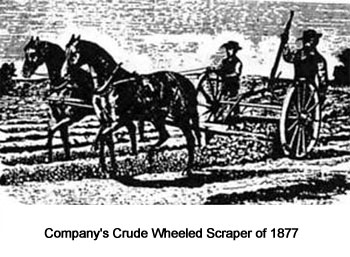 This was the same strange looking machine, which stood in front of Austin-Western general offices in Aurora, and was described as the world's first road grader. It was this machine along with ever-improved descendants that made the modern highway of today possible. Meanwhile back in Mount Prospect, Smith improved on the original scraper and his firm was contracted to build an Iowa section of the Burlington & Missouri River Railroad.
This was the same strange looking machine, which stood in front of Austin-Western general offices in Aurora, and was described as the world's first road grader. It was this machine along with ever-improved descendants that made the modern highway of today possible. Meanwhile back in Mount Prospect, Smith improved on the original scraper and his firm was contracted to build an Iowa section of the Burlington & Missouri River Railroad.
In the process, his scraper manufacturing revolutionized construction methods. In 1883, Smith finished his last railroad contract in Indiana. He concentrated on manufacturing scrapers from then to his death in 1910. By 1891 he had outgrown Mount Prospect and, perhaps as a result of Burlington, moved operations to Aurora, changing the firm name to Western Wheeled Scraper Company.
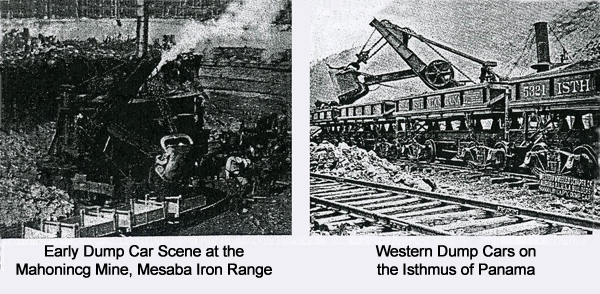
 In 1904, the firm's inventive genius emerged again in a perfected dump cars with twelve cubic yard capacity, operated by air. Within a year, capacity had been increased by over 50%. These cars became the backbone of earth moving operations that enabled the Panama Canal to be constructed ahead of schedule and below budget.
In 1904, the firm's inventive genius emerged again in a perfected dump cars with twelve cubic yard capacity, operated by air. Within a year, capacity had been increased by over 50%. These cars became the backbone of earth moving operations that enabled the Panama Canal to be constructed ahead of schedule and below budget.
Captain Smith remained in charge until his death in 1910 By then he had gained control of Austin Manufacturing, which dated from 1859 in Harvey, Illinois and had evolved along similar lines to Smith's Western. In 1934 a full merger was agreed, which included the sales organization known as Austin-Western Road Machinery Company of Chicago.
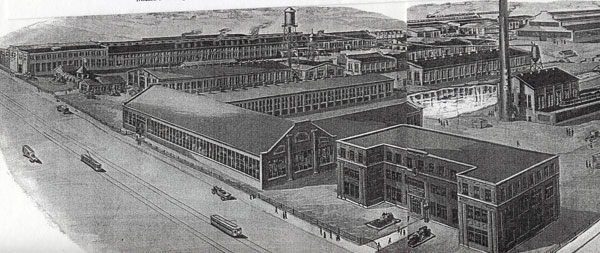
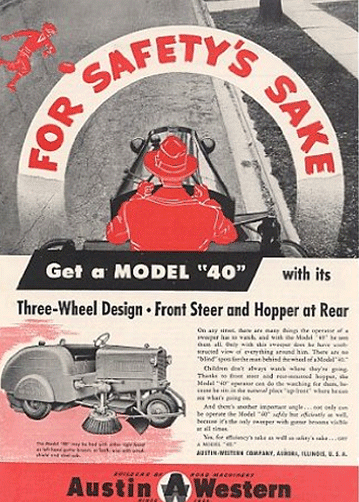 Aurora headquarters on Farnsworth directed both the large Aurora and Harvey plants, from which came industry firsts, which even before World War II included: steel reversible road grader; motor roller; crawler wagon; duel drive leaning wheel; diesel and four wheel drive graders. Austin-Western dump cars, graders, rollers, street sweepers, power shovels, scrapers and crushing plants spread to every developed community of the globe.
Aurora headquarters on Farnsworth directed both the large Aurora and Harvey plants, from which came industry firsts, which even before World War II included: steel reversible road grader; motor roller; crawler wagon; duel drive leaning wheel; diesel and four wheel drive graders. Austin-Western dump cars, graders, rollers, street sweepers, power shovels, scrapers and crushing plants spread to every developed community of the globe.
At the beginning of 1962, the company cited 1961 as one of most successful in its long history and looked forward to another successful year of further product development and overall progress. But all would not be well in the future. In 1953, Austin-Western had been acquired by Baldwin Hamilton Lima.
Until the 1930's, Baldwin Locomotive was among the largest of US industrial firms. By 1935, they were bankrupt, victim of GM's Electro Motive diesels engines which antiquated steam. World War II provided a temporary respite Westinghouse bought Baldwin in 1948. Failing to turn it around, Baldwin was merged with Lima Construction of Ohio in 1950. By 1956 the last steam locomotive was produced. The desperate attempt to diversify to road construction acquisitions wasn't successful.
In 1973, construction equipment operations including Austin-Western were bought by Clark Equipment. In 1978 Austin-Western Aurora operations closed. Production of cranes shifted to Lima Ohio and rough terrain graders to Texas. Both operations were discontinued as Clark was dissolved in 1980. Minnpar has provided some parts and other services on existing equipment since then, but without ties to Aurora.
And so ends the saga of Austin-Western. In its springtime, it was sufficiently nimble to thread a way to move from picks and shovels of railroad building by introducing modern machinery that antiquated those picks and shovels and made modern highway building possible. But after nearly a century, it was saddled with the last to fall of the great rail suppliers. With the shift from rail to highway dominance, down Austin-Western also went, despite having helped make the rise of highways possible in the firm's glory years, so very long ago.
Sources:
Aurora Beacon News, Western Wheel Scraper 50 Year History
Austin Western's Unique Look was by Famous Industrial Designer, Alex Tremulus
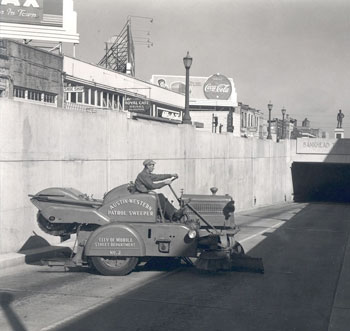 According to information I found on the internet, the initial design of Austin Western sweepers – apparently prior to the sweeper line being purchased by the Austin Western Machinery Co. – was done by an industrial designer named Alex Tremulus. (If anyone has information on the company when owned the the "two very nice ladies" described below, or info on when/why it was sold to Austin-Western Machinery Co., please let us know.)
According to information I found on the internet, the initial design of Austin Western sweepers – apparently prior to the sweeper line being purchased by the Austin Western Machinery Co. – was done by an industrial designer named Alex Tremulus. (If anyone has information on the company when owned the the "two very nice ladies" described below, or info on when/why it was sold to Austin-Western Machinery Co., please let us know.)
Here's a link to some other designs Tremulus did for Ford Motor Company. These were found on Hemmings Blog under the title: Fords of the Future. This link provides more insight on how what became the Austin Western sweeper had such a unique and stylish design.
The following is quoted as being in Alex Tremulis' own words:
"Two very nice ladies headed up this company. The firm was turning out one street sweeper a week, an efficient three-wheeled unit selling for less than half of what the big companies were getting. Stylist Glenn Tammen and I got the task of improving the design and we covered up all of the exposed machinery and brushes with a streamlined cover and painted it bright canary yellow in place of the no color scheme at all.
The result? A year later, we were invited to a company party and the two little old ladies were beside themselves. Their plant was running seven days a week, three shifts a day to turn out up to 400 units a year.
'We had a nice peaceful life until this success hit,' they complained. 'Now we think we may sell the whole thing.'
The streamlined street sweeper had become an American institution, the first to sweep America beautiful."
We invite you to check out the previous article we did on model maker, Danny Downs, and the brass model he made of an Austin Western sweeper.
We're always on the lookout for more sweeper-oriented information we can add to the website, so keep us in mind if you find interesting information about sweeping.
|